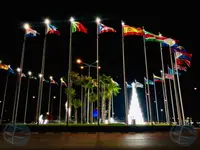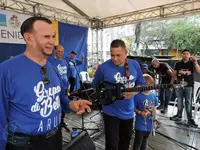
Everything You Always Wanted to Know About Holiday Traditions in Aruba
Aruba loves all kinds of celebrations, from birthday parties to carnaval and everything in between. Even hump day is a thing on this One happy island, called kibra siman in Papiamento. Literally translated in English: breaking the week. It has the exact same meaning as hump day, yet in Aruba it calls for elaborate happy hour celebrations and if you know where to find the right places, you’ll be treated to live music and ample dancing, too.
Therefore, it will be no surprise to learn that Aruba loves the Holiday Season, too. With its zest for everything and anything celebratory and festive, the local community can’t wait to dress up, show up and decorate for the end of year celebrations. Expect Christmas trees, twinkling lights and all sorts of shiny decorations to go up as early as mid- November.
Sinterklaas
The very first ‘main event’ to open the holiday season in Aruba, is the official arrival of Sinterklaas. Sinterklaas is the Dutch version of Santa Claus, who is extremely popular with -young- children as he showers those who were nice with presents and candy. He arrives by steamboat from ‘Spain’ in the second half of November, the weekend before Thanksgiving, and attracts enormous crowds of families with children to the main harbor of Oranjestad to welcome him to Aruba. In the weeks leading up to Sinterklaas Eve on December 5, kids can place their shoe in front of the door or by a chimney in hopes that their empty shoe will be filled with typical candy like pepernoten and marzipan or small toys the next day after a visit by Sinterklaas and his helpers, called Pieten, or Pete’s. Sinterklaas travels over the island on a white horse and he is formally dressed in red velvet bishop’s robe with a golden staff and carries a long white beard, while the Pieten are dressed in costumes with festive colors, wearing hats with feathers and showcase funny behavior. His helpers carry a big book with a list of names how’s been naughty or nice. On December 5 gifts miraculously appear in a bag at each house by -often- invisible Sinterklaas and his Pieten. Only a happy few get to meet Sinterklaas or have him over for a house visit. Meanwhile, adults have gift-exchange parties and games, often with satirical poems to accompany the gifts.


Kerstboomlandia
Sinterklaas hasn’t left the island yet, or a huge tent on Vondellaan erects with hundreds of Christmas trees, called Kerstboomlandia. Aruba is an island with a desert climate so over 90% of all Christmas trees used for the Holidays are imported, and therefore quite costly. A large amount of these fresh, imported trees are collected for sale in the Kerstlandia tent. Because of the warm temperatures in Aruba, the Christmas trees give of an extra strong ‘tree smell’, which makes a visit to Kerstboomlandia very worthwhile. Most locals set a real tree for only two weeks as the high temperatures also cause for the needles of the tree to drop sooner than in colder climates; those who do not appreciate the fabulous smell of a real tree or can’t stand the mess of the needles settle for an artificial tree. As a side note: Boardwalk Boutique Hotel sets a real tree in the hotel lobby, and this is a very special tree with its own persona! Coni The Conifer lives in the Boardwalk Boutique Hotel gardens 11 months of the year and is relocated annually to the airconditioned lobby during the entire month of December.


Family, food and recipes
In addition to Ham di Pasco, a Christmas Ham decorated with pineapple slices and bright red cherries, various local dishes are served for the holidays such as ayaca, a traditional holiday dish that finds its origin in Venezuela. The holiday seasons is typically a time when local families come together to cook and celebrate, and each family has their own take on the ayaca recipe. In general, these pockets of cornmeal dough filled with meat, spices, prunes, raisins, cashews and more, are folded in banana leaves and tied up with cooking rope giving this dish the appearance of a present to be unwrapped. The entire holiday season is filled with gatherings and festivities with lots and lots of food and drinks. A traditional drink served during the holidays in Aruba is ponche crema, a Caribbean variety of eggnog, while cashupete, a cake that consists of heavy cashew cream, is a favorite traditional dessert. At various local bakeries you will also be able to get other typical cakes and breads that make for a festive meal, such as pan dushi, small bread rolls. Towards the end of December, you will see stands for oliebollen pop up everywhere. This typical Dutch snack is traditionally only eaten on New Year’s Eve and the days leading up to the end of the year. This deep-fried dough covered in powder sugar in the shape of a small ball is eaten either naturel, or filled with apple pieces, or raisins.



Roundabout glam
Over the past fifteen years Aruba added countless new roundabouts; some find them annoying and confusing; others bless their arrival as traffic now flows much more smoothly, having replaced traffic lights on many crossings. During the Holiday season various neighborhoods and companies adopt a certain roundabout and deck its entire surface and trees with lights and Christmas décor. Some of the decorating teams do such an amazing job that you might find it worth your while to go on a tour of the island after sunset and pass some of the main roundabouts on Sasaki and on the connecting road from Tanki Flip (near the fire station) towards Tanki Leendert, Paradera and Santa Cruz. While you are on the road, also keep an eye out for the spectacular city of lights in Seroe Pretu, a neighborhood in San Nicolas in the south of the island. Here, an entire community pitches in and builds an entire display out of Christmas lights, often depicting a landmark in Aruba. Entrance is free; prepare for crowds and difficulty parking between the hours of 7-9 pm. It does get better after 9.



Pagara
Not everyone is a fan of this tradition in Aruba that pops up in the last days of the year, but the pagara, a long string of Chinese firecrackers, has special meaning to local businesses and members of the community. The lighting of the pagara is a festive happening for which entire companies and neighborhoods flock to the street to witness the explosion of noise and smoke. The pagara finds its origin in Chinese customs to ward off evil spirits for the coming year. By far the biggest happening is the lighting of the pagara at Wind Creek at Renaissance Aruba, where the string of firecrackers covers almost the entire oceanfront boulevard and masses of locals and visitors gather to celebrate the year end and be part of this loud ceremony. The longest pagara with millions of firecrackers going off for well over an hour is lit across the street from Boardwalk Boutique Hotel, at the Aruba Marriott Resort. During the week between Christmas and New Year’s Day you should not be startled or surprised to find yourself confronted with a spontaneous firecracker going off in the middle of the street. Boardwalk used to light a pagara as this holiday tradition is so intertwined with the customs in Aruba, however stopped this celebration a few years ago as it does not fit in our sustainable practice, nor in our care for the environment.

Fireworks on Palm Beach
While the pagara offers much noise and smoke, Aruba’s fireworks at twelve midnight on New Year’s Eve are a true spectacle that will make Disneyland’s main street fireworks look bleak in comparison. Unlike in the US, in Aruba it is legal to set off your own firework and do so in public areas, on the street etc. Straight after midnight you will see the entire skies above Aruba light up with the most amazing fireworks. On the beach in front of the Aruba Marriott Resort & The Ritz-Carlton, across the street from Boardwalk Boutique Hotel, you will be able to witness the islands’ largest and longest lasting firework show with the most beautiful willows and strobes filling the skies above Palm Beach with sparkling stars and colors. Usually, these showy fireworks will go on for about 15 minutes and draw great crowds to the beach, especially in front of the Aruba Marriott hotel.

NYE Celebrations at Boardwalk Beach
If you want to see Aruba’s magnifice fireworks show in Palm Beach you’ll have a fantastic view from the Boardwalk Beach area. As an extended service to our guests you can now book a festive New Years Eve in Aruba celebrations package. This package includes portable beach chairs to place front row on the water's edge, a cooler with chilled champagne and a charcuterie box catered by The Coco Café. In short, the excellent circumstances to have a festive and memorable oceanfront New Years Eve celebration. While the fireworks show in Palm Beach starts at midnight, you are most welcome to find your preferred spot on Palm Beach in the Boardwalk Beach area in the hours leading up to the sparks coloring the sky, with your feet in the sand and a chilled glass of bubbly at hand. Please ask our team at the Front Desk about this festive package, how to make reservations and what to expect on December 31.

Gaita
If by now you are still reading this blog, you’ve gotten to know almost everything under the sun when it comes to celebrating the Holidays in Aruba, yet one very important holiday tradition we still need to address: the music. While there are typical waltzes that serve as Aruban Christmas songs, gaita is most linked to Aruba’s holiday traditions. This type of Christmas music found its origin in Venezuela and was fully embraced on the island. These up-tempo musical arrangements are often performed in groups and can be enjoyed during live performances all over the island, and on the radio. Special mention in this regard for local radio program Na Drempel di Fin di Aña. This program already celebrated 30 editions and grew out as one of the typical Christmas traditions in Aruba. Na Drempel is hosted by radio personality Erin Croes and airs three times a week from 6-9 pm on Monday, Wednesday and Friday, and starts mid-October as a countdown to Christmas. The show plays lots of traditional holiday songs performed by gaita groups and by local favorites like Grupo di Betico. The radio show airs on frequency 96.5 FM.

Dande
During the days and hours leading up to New Year’s Day small groups of musical performers and singers go door to door, visiting companies as well as private groups of families and friends to deliver musical well wishes. Both lyrics and rhythm of the songs are repetitive, always including the expression ‘Ay nobe’, a derivation of Aña Nobo, or New Year in English. Traditional Aruban instruments like the raspa (a rasp) and the tambu (a traditional drum with a leather top, often made of goat skin) are used by the Dande performers, giving these musical well wishes a very authentic sound.

Picture credits to VisitAruba.com, Aruba.com & Aruba.nu